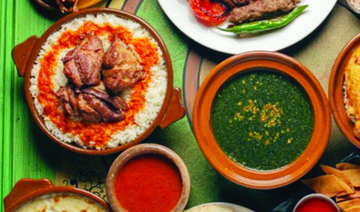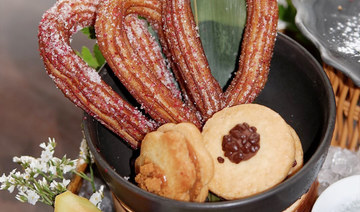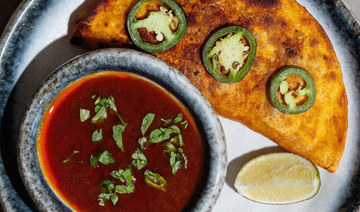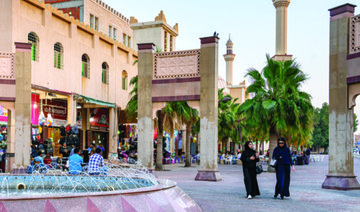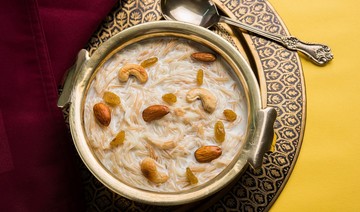PARIS: Cheese is making a delicious comeback in gastronomic circles. From glorious dishes of pasta served in cheese wheels, to fresh takes on the traditional Swiss raclette — a dish of melted Alpine cheese over vegetables or charcuterie — cheesy creations are taking over social media sites and have international foodies drooling. But when it comes to serving cheese in our own homes, we often resort to tried, tested and admittedly boring staples.
So the next time you wish to impress discerning guests with a sophisticated cheese board worthy of a Michelin-star restaurant, ditch the cheddar and take the advice of experts at the Isigny Ste Mere production facility in Normandy.
The dairy cooperative is famous for its cream, cheese and butter, and is located in the dairy heartland of France, known for its rolling green pastures and herds of wandering cows. Arab News toured the facility to find out more about how the cheese is made and how it is best served.
Normandy is widely celebrated as the dairy capital of both France and Europe, and boasts a clutch of Protected Designation of Origin (PDO) cheeses, a status that is awarded by the EU and is only achieved when cheese is made the traditional way using top-quality ingredients sourced from farms in a particular area.
So if you are a cheese lover and want to learn more, read on for a guide on which cheeses to serve up at your next soiree. If you wish to host the ultimate cheese-tasting party, a top tip is to cleanse your palette with water, bread or a sweet apple between cheeses, according to award-winning cheese-monger Francois Robin, who is one of only 22 “Meilleurs Ouvrier de France” in the cheese category.
Camembert
Perfect for dipping, camembert is a popular pre-dinner snack, and can be baked in the oven until it is gooey and hot. Simply pierce the top of the cheese with a sharp knife and slide pieces of garlic and thyme into the small slits. Place the cheese on a baking tray in its box and drizzle over with olive oil, cook at 200 degrees Fahrenheit until the center is perfectly melted, and scoop up the cheese with vegetable sticks on crackers.
At the Isigny Ste Mere facility, the unpasteurized milk that goes on to become PDO Normandy camembert is heated in vats and then seeded with lactic cultures and rennet. The rennet curdles the milk before the molds are filled, layer by layer, by hand or with a mechanical ladle, in a humid room beset with a maze of pipes. Each layer rests for 45 minutes before the next layer is added, ensuring the cheese is supple.
The camembert is then salted and put to rest in a well-ventilated, cold room called a hâloir, where it ripens for 12 days. It is then packed into wooden boxes and continues to ripen, with four weeks considered the full ripening period for a round of camembert. At this stage, it is gooey and creamy all the way through, as opposed to the chalky centers of a camembert that has only ripened for two weeks.
Pont l’Evèque
Pont l’evèque is a subtle, soft rind cheese that matches perfectly with camembert, but can be differentiated due to its square shape. You will notice a faint whiff of hazelnuts when you enjoy this particular cheese, best served with dried figs and freshly made bread.
It is one of the oldest French cheeses still in production, and can be traced back to the 12th century, when it was called d’Angelot. In the 17th century, the name was changed to reflect the village in which it was made, Pont l’Evèque in Normandy.
At the Isigny Ste Mere facility, which produces a PDO pont l’evèque, milk is heated and rennet is added to coagulate it before the curd is cut and the whey is drained off. The product is left in molds for four days and salted on the fifth, before being washed in salt water on the seventh day. The cheese is then left to ripen in the hâloir for anywhere between 13 days and six weeks.
Mimolette
If you are looking to liven up your cheese board with a wild card, a strong, hardy mimolette is the way to go. This cannonball-like hard cheese is a shocking orange color and has a sweet, almost caramelized taste with a fudgy finish.
The electric color is due to the use of fruit from the Central American anatto tree in the production process. The hue was chosen by King Louis XIV in the 18th century to distinguish French cheeses from Dutch products, according to the Isigny Ste Mere tour guide. This cheese is best served with date syrup and fresh bread or a sweet onion relish, and can also be sprinkled over a green salad.
The mimolette at Isigny Ste Mere, which was awarded the coveted label rouge sticker signifying high quality, is made with milk that is then heated and seeded with lactic cultures to develop the flavor. Rennet is added, followed by a natural coloring agent from the anatto fruit. The resulting curd is cut, allowing the whey to drain off, and then pressed and cut into cubes. After this, it is placed into cloth-lined molds before being pressed for a second time.
At this stage, the cheese takes on its distinct final spherical shape, and is placed in a saline bath for 72 hours before it heads to the curing chamber, where it develops a thin layer of mold. This cheese is not for the fainthearted, as the fine coat of mold is typically burrowed into by cheese mites. These creatures take off the layer of mold and give the cheese its finished look.
Perfect your cheese platter with tips from France’s dairy heartland
Perfect your cheese platter with tips from France’s dairy heartland
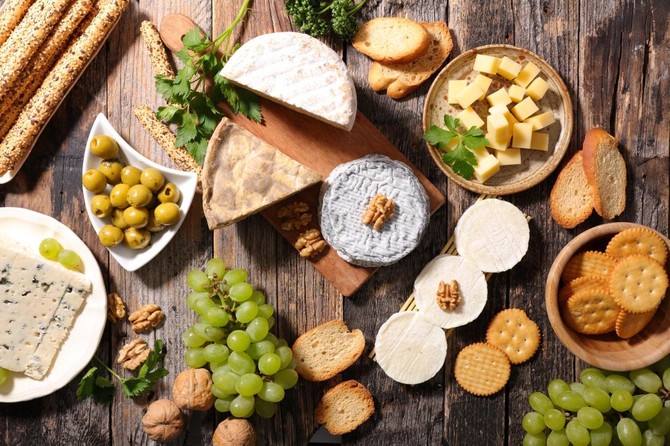
Where We Are Going Today: ‘Kunafa Azmiah’
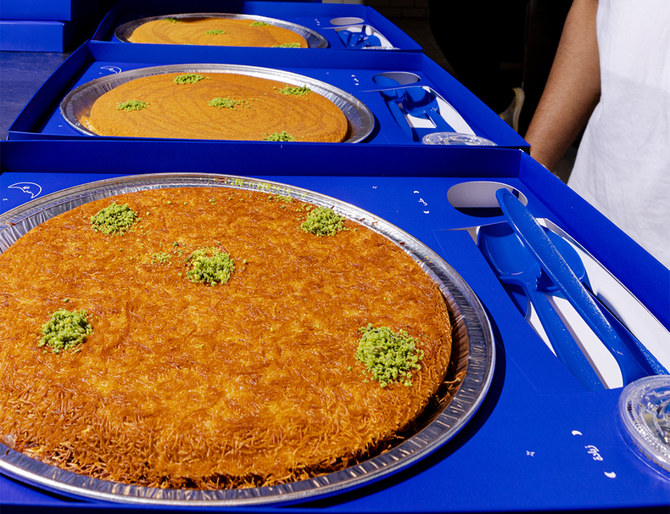
- Their menu features a variety of original kunafa options, including the classic version as well as a crispy cream fingers that promises the same great taste with a unique twist
Choose from a variety of sweets from Kunafa Azmiah to indulge your senses with an Arabic sweet flavor. The store specializes in producing the Arabic sweet kunafa in a variety of forms, including soft, hard and in tiny, bite-sized versions.
Indulge in the finest kunafa, carefully designed to satisfy the authentic Saudi taste.
Kunafa is served piping hot from the oven, ensuring that each bite is a delightful experience. They use only the finest cream to create a luxurious filling that perfectly harmonizes the crispy pastry layers. 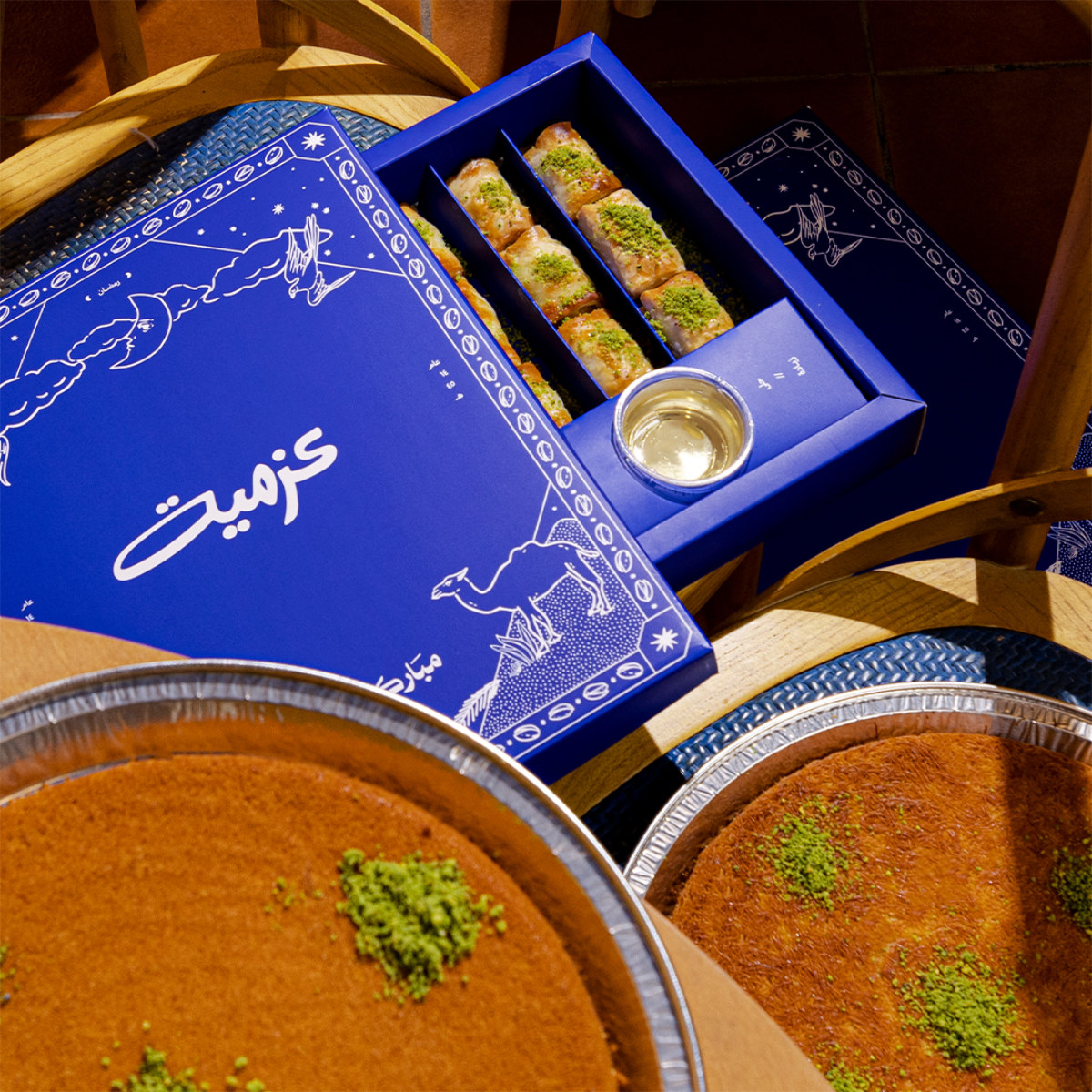
Their menu features a variety of original kunafa options, including the classic version as well as a crispy cream fingers that promises the same great taste with a unique twist.
For those craving extra sweetness, they offer kunafa topped with a delightful combination of shira (sugar syrup) and pistachios.
Their carefully guarded cooking techniques and premium ingredients ensure that every bite is a tasty masterpiece.
Many visitors opt for the hard kunafa, as it is crunchy but also melts in the mouth.
Whether it is a casual gathering or a formal event, kunafa is the perfect choice to impress your guests. Pair it with authentic Arabic coffee for a truly memorable experience.
The business now has 22 locations in Riyadh and branches are open in Jeddah and Dammam as well.
The brand’s packaging is well-designed and practical. The kunafa is served with spoons and a pie knife and is housed in a blue box with sugar syrup on the side. This packaging makes the kunafa a fantastic food to bring to parties and social gatherings.
The cost is about SR65 ($18). Go to @Azmih.kunafa on Instagram for additional details.
Recipes for success: Chef Lorenzo Buccarini offers advice and a pasta and caviar recipe

DUBAI: “I discovered my passion for cooking at a young age, being drawn to the sights and smells from my family’s kitchen,” Zenon Dubai’s executive chef Lorenzo Buccarini tells Arab News. “My earliest memory of cooking is helping my grandmother prepare lasagna. Those moments ignited a lifelong love affair with the culinary arts.”.
Zenon, located at Kempinski Central Avenue in the heart of Downtown Dubai, offers Mediterranean and Asian cuisine.
“Working with Zenon Dubai has been an enriching experience filled with creativity and collaboration, allowing me to push boundaries,” said Buccarini.
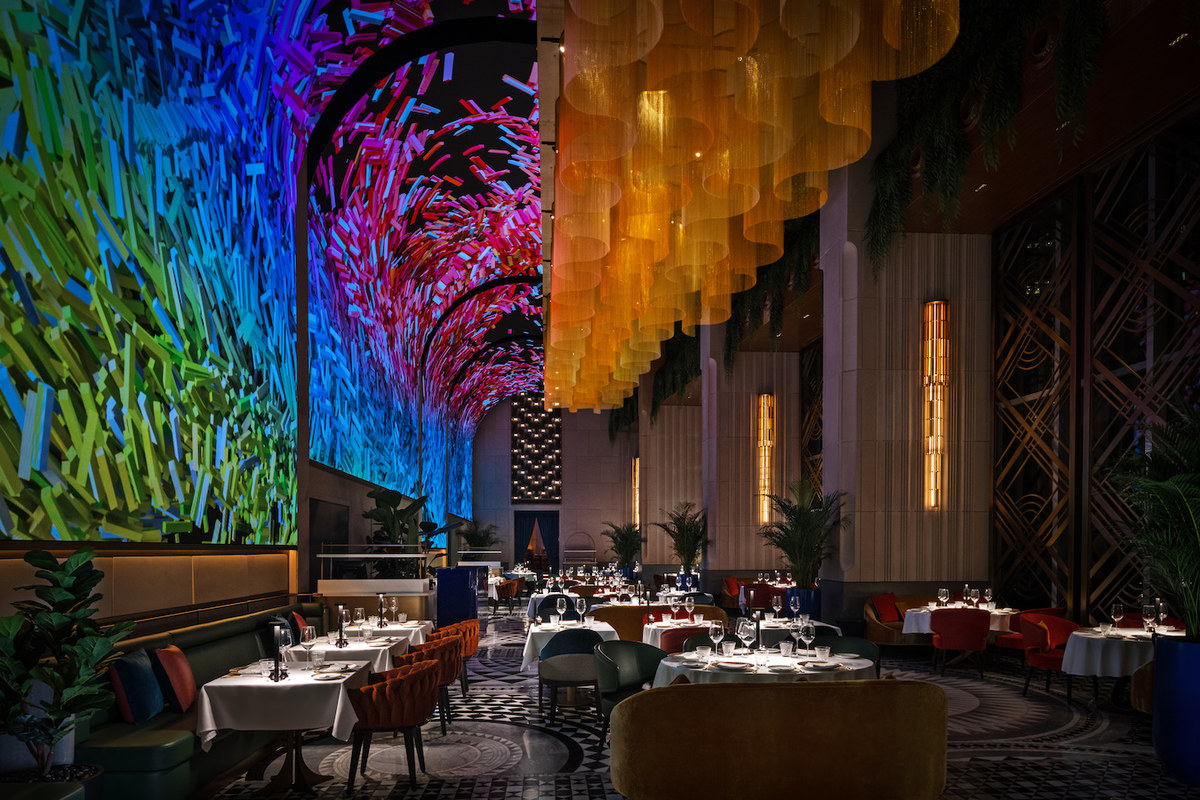
From the vibrant culinary scene of London in 2012 to Istanbul in 2014, Bali in 2016, and Morocco in 2018, Buccarini has dabbled in an array of cuisines over the years. Here, he discusses his go-to dish, favorite cuisine and most challenging dish to prepare.
Q: When you started out, what was the most common mistake you made?
A: Underestimating the importance of proper seasoning. Achieving the perfect balance of flavors is essential in every dish, and mastering seasoning techniques was a valuable lesson early in my career.
What’s your top tip for amateur chefs?
Invest in quality ingredients and don’t be afraid to experiment. Additionally, learn fundamental cooking techniques such as knife skills and proper seasoning, as they form the foundation of any great dish.
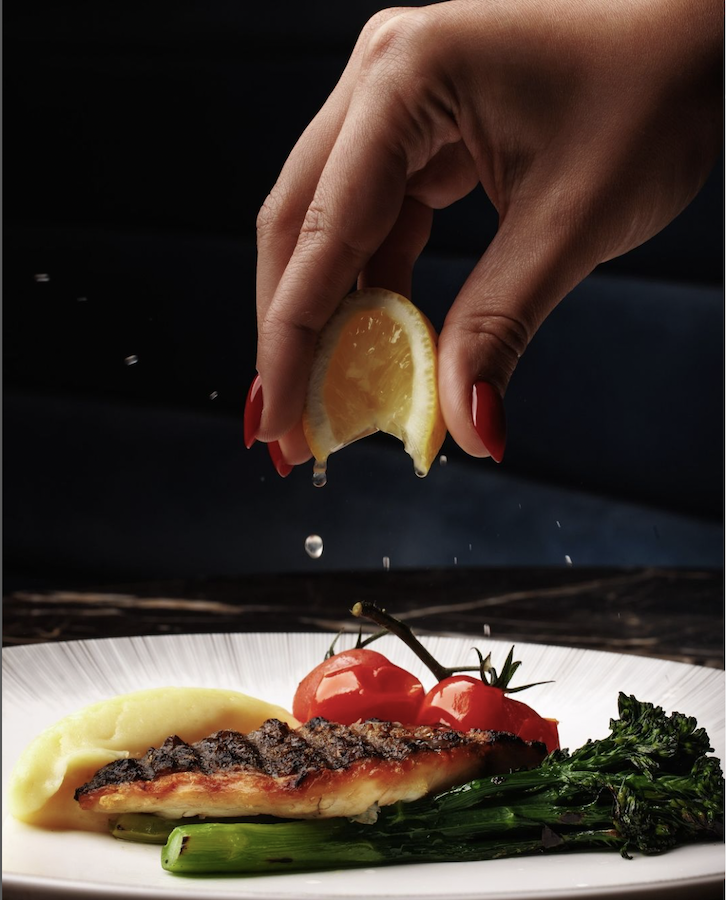
What one ingredient can instantly improve any dish?
Fresh herbs — whether it’s parsley, basil, cilantro, or thyme, incorporating fresh herbs adds depth and complexity to your cooking. They elevate the flavor of any dish.
When you go out to eat, do you find yourself critiquing the food?
Naturally, as a chef, I pay attention to the details if I’m dining out.
What’s the most common issue that you find in other restaurants?
Something I often notice is inconsistency in execution — whether it’s undercooked proteins, over-seasoned dishes, or lackluster presentation. Consistency is key to delivering memorable dining experiences.
And what’s your favorite cuisine when you go out?
I do enjoy exploring different cuisines, but if I had to choose a favorite, it would have to be classic Italian cuisine. There’s something inherently comforting and soul-satisfying about dishes like homemade pasta or a perfectly cooked risotto that never fails to delight the palate.
What’s your go-to dish if you have to cook something quickly at home?
Spaghetti aglio e olio. It’s a simple yet flavorful pasta dish made with garlic, olive oil, chili flakes, and parsley. It’s quick to prepare and showcases the beauty of minimalistic Italian cooking.
What customer behavior most annoys you?
It can be frustrating when customers request significant modifications to a dish without considering the integrity of the recipe. While accommodating dietary restrictions is important, excessive alterations can compromise the intended flavors and balance of the dish.
What’s your favorite dish to cook?
One of them is osso buco. It’s a classic Italian dish made with braised veal shanks, aromatic vegetables, and a rich tomato-based sauce. The slow cooking process allows the flavors to meld together beautifully, resulting in a dish that’s hearty, flavorful, and deeply satisfying.
What’s the most difficult dish for you to get right?
For me, mastering the perfect risotto has always been a challenge. Achieving the ideal balance of creaminess and texture while ensuring the rice is cooked to perfection requires precision and attention to detail. It’s a dish that demands patience and practice to get just right.
As a head chef, what are you like? Are you a disciplinarian? Or are you more laidback?
I try to maintain a balance between discipline and approachability. I do set high standards for my team, and I expect professionalism in the kitchen, but I believe in fostering a supportive and collaborative environment. Effective communication and mutual respect are essential for success in any kitchen.
Chef Lorenzo’s pasta, cream reduction and caviar
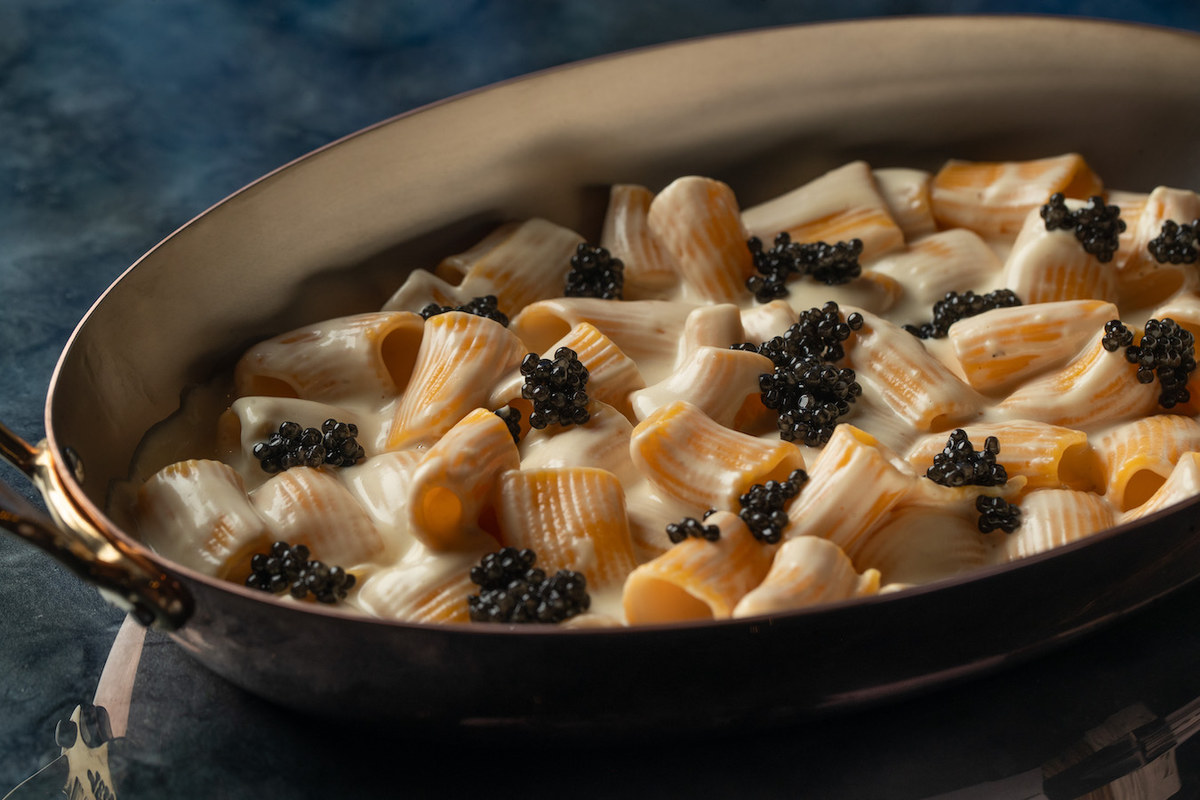
INGREDIENTS
For the cream reduction: 1L double cream; 500g dried porcini; 1L water
For the fresh pasta (can be substituted for store-bought pasta): 600g semolina flour; 1400g 00 flour; 8 fresh eggs; 300g water
INSTRUCTIONS
1. To reduce the cream, add it to a pan and gradually reduce the heat to a slow boil, stirring frequently. As the water boils off, the cream will be reduced. You want to reduce it by half. Then place the pan to one side.
2. For mushroom stock, add the dried porcini to a pan with the water and simmer for one hour. Strain immediately. Reduce the stock by ¾.
3. For the pasta, mix all ingredients together to make a dough. Put in the fridge for one hour. Remove from the fridge and shape it as you like (here at the restaurant we do rigatoni). You can just use standard, store-bought pasta too.
4. Cook the pasta in boiling water for five or six minutes (or as instructed for store-bought pasta), then drain.
5. Put 250g of the cream reduction and 20g of reduced mushrooms into a hot shallow pan. Add a pinch of salt. Add the pasta to the sauce. Stir. Add a little parmesan and top with caviar.
Where We Are Going Today: ‘Abou El-Sid’ authentic Egyptian restaurant in Jeddah
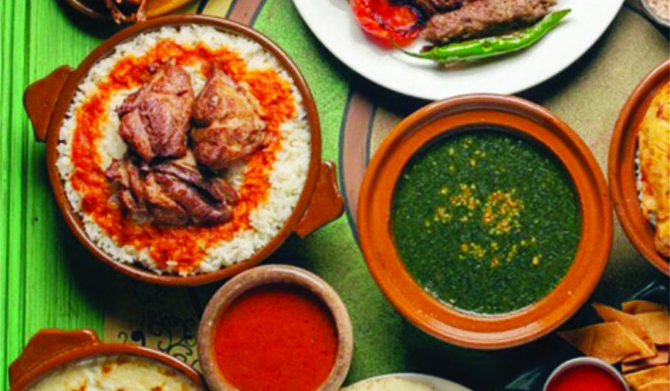
- Abou El-Sid truly offered an immersive and delightful culinary experience
As a food enthusiast eager to explore diverse cuisines, I recently visited Abou El-Sid, an authentic Egyptian restaurant in Jeddah.
The ambiance welcomed me with dim lighting, maroon walls, and nostalgic portraits of iconic figures from Egypt’s golden age of cinema.
I began with the lisan asfour soup, its flavorful broth setting the stage for the feast ahead. For mains, I enjoyed traditional dishes like molokheya, mixed grill, and mahashi, each bursting with authentic flavors.
To accompany my meal, I couldn’t resist the mumbar, a savory delight of lamb intestines stuffed with rice and spices.
Opting for outdoor seating, I basked in the warm sun and tranquil atmosphere, enhanced by classic Egyptian melodies playing softly in the background. Abou El-Sid truly offered an immersive and delightful culinary experience.
Who is Abou El-Sid?
In the heart of Fatimid Cairo resided a humble yet legendary cook, Al-Sayyed Abou El-Sid. Renowned for his exquisite dishes, influenced by the Ottoman Empire and Egypt’s rich gastronomic heritage, his culinary masterpieces attracted admirers from far and wide. Even the sultan, after tasting his creations in disguise, offered him a prestigious position as his chef.
However, Abou El-Sid realized that palace life couldn’t replace the warmth of his humble home. Despite the sultan’s refusal to let him go, he eventually escaped, leaving behind his culinary secrets in a book.
Centuries later, his book was discovered, inspiring an authentic Egyptian restaurant named after him. Today, Abou El-Sid’s legacy lives on through the restaurant, delighting diners with genuine Egyptian cuisine rooted in his timeless recipes.
For more details, visit @abouelsid_ksa on Instagram.
Where We Are Going Today: ‘The Lucky Llama’ restaurant in Jeddah
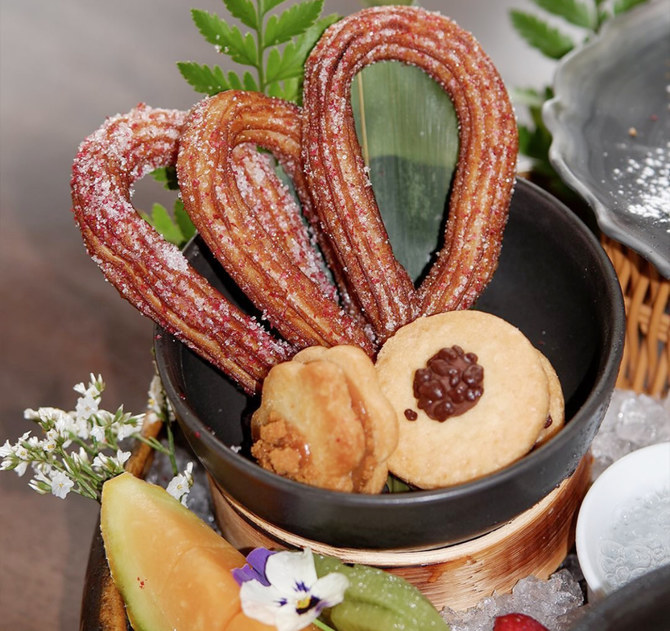
- Situated in the Al-Mohammadiyyah district, The Lucky Llama was established by chef Nihal Felemban
The Lucky Llama, a fine-dining restaurant in Jeddah, specializes in Nikkei cuisine, which combines culinary elements from Peru and Japan.
This unique style blends the colors, flavors, and aromas of both countries to create a harmonious dining experience.
Nikkei cuisine showcases the delicate and imaginative aspects of Japanese cooking alongside the bold and spicy flavors of Peru.
Situated in the Al-Mohammadiyyah district, The Lucky Llama was established by chef Nihal Felemban.
The cozy interior features plush seating, soft lighting and rustic decor, creating a welcoming ambiance.
I began with the salmon crispy rice, a blend of crispy rice, spicy truffle sauce, Norwegian salmon and jalapeno slices for a spicy kick. Each bite offers a harmony of flavors and textures, with the rice crunch complementing the buttery salmon.
To cleanse my palate between dishes, I chose the sake sour, a refreshing mix of sake, lime, yuzu and green tea syrup.
The nigiri menu stands out with vibrant flavors.
The scallop nigiri delighted with its rich umami taste, enhanced by truffle butter, parmesan and black lime zest.
My main course, the arroz con langosta, featured bomba rice, tom yum Nikkei broth, lobster and prawns — similar to paella but with a unique fusion twist.
For dessert, I enjoyed the sweet churros coated in cinnamon sugar, dipped in creamy dulce de leche.
The welcoming staff and top-notch service elevate the cozy ambiance. For more details, visit @theluckyllama.co on Instagram.
Top restaurant suggestions across the Kingdom during Eid holidays

- Suhail provides an authentic Saudi hospitality experience based on traditional cuisine
- Le Grenier a Pain in Riyadh is a charming French bakery and brunch spot
JEDDAH: The Eid breakfast, when loved ones come together to share delicious food and create lasting memories, is a cherished tradition. If you are looking to elevate your Eid breakfast experience, here are some top restaurants from around the Kingdom:
Suhail
Suhail provides an authentic Saudi hospitality experience based on traditional cuisine. Its ambiance takes inspiration from the captivating allure of the Arabian Peninsula desert, offering a comfortable setting for diners.
Lute Twaiq
Indulge in Italian and Levantine cuisine at Lute Twaiq. The Riyadh restaurant offers a breakfast buffet featuring traditional Italian and Levantine delicacies, including pasta, risotto and Neapolitan pizzas. Options like the eggplant beef hamsa are also available, prepared in the Neapolitan style. Eid breakfast starts at 6 a.m., perfect for early morning celebrations. Dammam residents can also enjoy Lute Twaiq at a branch in the city.
Le Grenier a Pain
Le Grenier a Pain in Riyadh is a charming French bakery and brunch spot. The menu features an array of French baked treats, including flaky croissants, buttery pain au chocolat and indulgent quiches. For Eid breakfast, Le Grenier a Pain serves specially prepared dips and diverse cheese platters, ideal for sit-down family gatherings or as a grab-and-go option.
ALFOLK
Enjoy breakfast at ALFOLK in Shangri La Hotel, featuring an international cuisine spread for SR595 ($158) per person. Alongside delicious dishes, guests can enjoy live music by two talented musicians, a photo booth and fun activities like face painting and clown performances. A fun-filled morning is the perfect start for Eid festivities.
The Waterfront Kitchen
The Waterfront Kitchen serves breakfast from 7 a.m. to 11:30 a.m. After enjoying a delicious meal, guests can continue their Eid celebrations with the regular lunch menu. Families can also take advantage of two hours of complimentary access to the kids’ club.
Burnt restaurant
Celebrate Eid at Burnt restaurant with a morning feast featuring a curated menu of dishes. Try the cheese platter, offering three dips paired with flavorful accompaniments for SR43. The restaurant also serves fried Asian eggs, a fusion of roasted potato and kohlrabi with Korean chili and miso, topped with fried eggs and sesame, for SR24.
Atareek Al-Madi
Atareek is a cultural hub featuring a museum, art gallery and space for Hijazi folk celebrations. It showcases traditional karweet and mirkaz wooden benches adorned with intricate Arabesque designs. Atareek’s Eid breakfast serves popular Saudi dishes like mugalgal, mandi lamb, Saudi white coffee and Ta’ateemah.
Pattis France
Pattis France, nestled on Prince Turki Corniche Road along the Alkhobar waterfront, provides a refined setting for an elegant Eid morning with family. The menu boasts a variety of egg dishes — scrambled, poached, or as omelets — alongside French baked treats and artisan desserts.
Fatte w Snobar
Fatte w Snobar offers authentic Levantine cuisine across multiple branches in Alkhobar, Dammam, Al-Ahsa, Abha, Al-Qassim and Madinah. The restaurant provides convenient breakfasts and grab-and-go packages perfect for Eid. These curated boxes feature a variety of dishes, including creamy hummus, foul, crispy falafel, succulent kebdah, omelets, assorted cheeses, pickles and fresh salads.
Mild
Located in the heart of King Abdullah Branch Road in Madinah, Mild offers a modern culinary experience perfect for Eid breakfast. With a chic and contemporary interior, Mild presents a carefully crafted menu that blends international flavors with local inspirations. From cheese platters to Arabic falafel bowls, refreshing falafel salads to bold bruschetta bowls, and Mexican omelets to Tunisian shakshuka, there are choices for every palate. With options ranging from sandwiches to tacos and focaccia, Mild ensures a pleasant dining experience for all.





